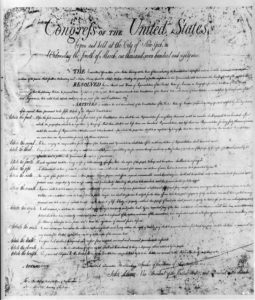
The United States Constitution exists as a living, organic document, one that can be amended for the benefit of the nation and its citizens as it changes over time. Today, there are 27 Amendments total. The first 10 are commonly known as the Bill of Rights. Did you know the Georgia state Constitution also contains a Bill of Rights?
When the United States Constitution was drafted in 1787, it did not include a section that explained the individual rights of its citizens and the limitations on the Federal government. The Constitutional Convention of 1787, a group of representatives from 12 American states, presented this Constitution to the states and waited for nine states to adopt it before it could go into effect. Many state legislatures, however, protested the Convention’s decision to omit protections for citizen’s individual rights. They expected these rights to be explicitly stated in the new Constitution, as many were in state constitutions and most famously in the 1776 Virginia Declaration of Rights. In response to these complaints, supporters of the Constitution promised to add a bill that outlined the rights of the citizens and limitations on the central government once the states ratified the Constitution. The First Congress proposed 19 amendments and approved 12 of them. The dozen amendments were sent to the states for ratification. Ten were ratified, becoming what we know as the Bill of Rights.

Despite advocating for a bill of rights, Georgia did not incorporate one into its first state constitution. In fact, Georgia citizens lived under three state Constitutions between 1777 and 1860, but none included a formal Bill of Rights. The first Georgia Constitution that featured one was adopted in 1861. The state adopted this Constitution after it seceded from the Union to join the Confederate States of America. While there are several theories as to why this change occurred, many historians agree that the secession crisis led the Georgia government to demonstratively show its citizens that joining the Confederacy would not allow the state to violate the individual liberties of its citizens or abandon the fundamental principles on which the United States government was based. Since 1861, the government of Georgia has ratified 6 more state constitutions. During this time, the state added to the Bill of Rights and updated its terminology to fit modern times.
The Bill of Rights in the Georgia State Constitution is different than the Bill of Rights in the United States Constitution, which are the first ten amendments to the Constitution. The Georgia Bill of Rights is included in Article I of the Georgia state Constitution, rather than additional amendments. Article I contains 28 paragraphs that outline the rights of Georgia citizens. The state’s Bill of Rights is similar to the nation’s in that it protects the freedoms of its citizens, guaranteeing freedom of speech, freedom of the press, and freedom of religion. While the two bills share these similarities, they are different.
Unlike the US Constitution, Article I of the Georgia Constitution protects the citizen’s freedom of conscience. Article I also protects the right to participate in two particular traditions in Georgia: fishing and hunting. While the state can enforce laws and regulations that pertain to fishing and hunting, those stipulations must be for the benefit of the public. The United States Bill of Rights states in Amendment VIII that no one convicted of a crime can be subjected to “cruel and unusual punishments.” The phrase “cruel and unusual punishments” can be interpreted many ways. Most states provide their own limitations for punishments for criminals. In Georgia’s Bill of Rights, Paragraph XXI of Article I states that a Georgia citizen convicted of a crime cannot be banished from the state or whipped for their crime.
The bills of rights in the Georgia state Constitution and the United States Constitution have some differences, but at their core, share similar purposes. The individual rights of citizens are outlined in both, and the two constitutions can be amended or changed over time to protect the people the government serves.
To learn more about amendments and the Bill of Rights in both the Georgia Constitution and the U.S. Constitution, see this month’s Inquiry Design Module. You can also explore more on the topic at the following links.
New Georgia Encyclopedia (Trustee Georgia, 1732-1752)
Yale Law School, The Avalon Project (Charter of Georgia: 1732)
The Constitution Center (The Constitutional Convention of 1787: A Revolution in Government)
The Constitution Center (The Declaration, The Constitution, and the Bill of Rights)
Library of Congress Exhibits (Creating the United States: The Bill of Rights)
Today in Georgia History (January 2)
Today in Georgia History (January 19)
New Georgia Encyclopedia (Georgia Secession Convention of 1861)
New Georgia Encyclopedia (Georgia Bill of Rights)
New Georgia encyclopedia (Georgia Constitution)
Georgia Archives, The Constitution of the State of Georgia, 1861
